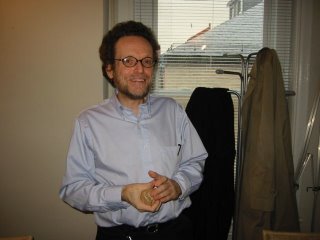Thomas Pogge on "Social Justice and Pharmaceutical Innovation"
by Ben Krohmal

This week at CPTech Thomas Pogge presented “Social Justice and New Approaches to Promoting Pharmaceutical Innovation,” based roughly on his paper “Human Rights and Global Health: A Research Program.”
Thomas began his presentation with a brief exposition of one of his better known moral arguments, namely that the imposition of global institutions (e.g. TRIPS) that prevent the poor from satisfying their basic needs constitutes a violation of human rights. As a result, changing existing policies and institutions to better serve the poor is not a matter of charity or being a Good Samaritan but rather is mandatory in order to stop violating the rights of the global poor.
Thomas followed with an impressive overview of the scope and ramifications of global poverty before describing his proposal for making medical innovations more responsive to global medical needs.
Pogge proposes giving innovators a choice between two types of patent for new drugs and vaccines, Patent I or Patent II. Patent I is the same as pharmaceutical patents currently issued. Patent II requires open-licensing the innovation in exchange for a yearly payment for some duration based upon the actual impact of the innovation on the global disease burden. Thomas suggests that with the prospect of substantial rewards, innovators would opt for Patent II rather than Patent I to cover most drugs for diseases that significantly impact the developing world. Basing rewards on actual medical impact is intended to solve the “last mile problem” of getting medicines from the cargo plane to the people who need them: Patent II holders will have strong incentives to create the infrastructure necessary to ensure their product does as much good as possible. Funding for Patent II rewards would be provided by a “coalition of the willing” – countries would sign up and pledge to pay a given amount per unit of medical benefit (QALY, DALY, or some other metric) provided by drugs under Patent II, with richer countries expected to pledge more. As more countries sign on, reward amounts or the scope of eligible innovations could be increased (for instance, to begin with only drugs for communicable diseases might be eligible for Patent II, but eventually this might be expanded to all drugs).
After the presentation, much of the discussion involved comparing the Pogge proposal to other proposals for accessible medical innovation such as the Kremer et. al APC/AMC proposals, the Love/Hubbard prize fund/R&D Treaty approach, the Sanders Bill (HR 417), the Hollis voluntary prize fund, proposals to combine outcomes based rewards as incentives to voluntary licenses of patents to a patent pool for developing countries (possibly targeting CIPIH type II and III illnesses), and various patent buy-out proposals.
Particular attention was devoted to discussing the rationale for offering innovators a choice between Patent I and Patent II, rather than doing away with Patent I altogether. Thomas suggested that offering innovators a choice would be more politically feasible because the pharmaceutical industry might support the proposal. Others suggested that the political advantages of making Patent II mandatory might be greater, since it would presumably offer greater benefits to patients in rich countries (because given the choice, most innovators would chose Patent I for drugs with significant rich-country markets).
Thomas also answered questions about his proposal that countries pledge to pay an amount per unit of benefit rather than a fixed amount per year. Some suggested that countries would be unlikely to go along with open-ended financial commitments. Thomas stressed that one advantage of pledging funds per unit of benefit would be that countries would only pay if the proposal were successful in promoting the development of clinically significant open-licensed drugs. He also suggested that having a fixed amount awarded per year regardless of the quality of innovations could encourage collusion among innovators in an attempt to game the system – though he agreed that the possibility of this would be remote.
The majority of the questions focused on how a drug’s actual impact on the world’s disease burden would be measured and isolated from other influences. Thomas explained that the process would require “cutting corners” since an exact calculation of impact would be impossible. He suggested that standard public health sampling methodology be used to estimate the expected progression of diseases over the next decade or so. A drug’s impact for the purpose of determining Patent II rewards would be determined by comparing expected disease burden to actual disease burden as determined by similar sampling methodology. Background factors causing fluctuations in disease burden would be ignored and so introduce an added element of risk for innovators, but according to Thomas this would be no different than the risk faced by auto–makers that gas prices will increase and suppress demand for SUV’s. Innovators would work out rules in advance to decide how to divide rewards in cases of sequential innovation and multiple treatments for the same disease. While basing rewards upon expected rather than actual medical impact would be more difficult, Thomas suggested that using actual impact would be preferable because it addresses the “last mile” problem.
Overall reaction to many aspects of the proposal was positive, though many attendees expressed remaining concerns – particularly about the possibility of obtaining the requisite drug impact information, the ability of innovators to agree amongst themselves to an adequate system for dividing shared rewards, and the political feasibility of open ended financial commitments.

This week at CPTech Thomas Pogge presented “Social Justice and New Approaches to Promoting Pharmaceutical Innovation,” based roughly on his paper “Human Rights and Global Health: A Research Program.”
Thomas began his presentation with a brief exposition of one of his better known moral arguments, namely that the imposition of global institutions (e.g. TRIPS) that prevent the poor from satisfying their basic needs constitutes a violation of human rights. As a result, changing existing policies and institutions to better serve the poor is not a matter of charity or being a Good Samaritan but rather is mandatory in order to stop violating the rights of the global poor.
Thomas followed with an impressive overview of the scope and ramifications of global poverty before describing his proposal for making medical innovations more responsive to global medical needs.
Pogge proposes giving innovators a choice between two types of patent for new drugs and vaccines, Patent I or Patent II. Patent I is the same as pharmaceutical patents currently issued. Patent II requires open-licensing the innovation in exchange for a yearly payment for some duration based upon the actual impact of the innovation on the global disease burden. Thomas suggests that with the prospect of substantial rewards, innovators would opt for Patent II rather than Patent I to cover most drugs for diseases that significantly impact the developing world. Basing rewards on actual medical impact is intended to solve the “last mile problem” of getting medicines from the cargo plane to the people who need them: Patent II holders will have strong incentives to create the infrastructure necessary to ensure their product does as much good as possible. Funding for Patent II rewards would be provided by a “coalition of the willing” – countries would sign up and pledge to pay a given amount per unit of medical benefit (QALY, DALY, or some other metric) provided by drugs under Patent II, with richer countries expected to pledge more. As more countries sign on, reward amounts or the scope of eligible innovations could be increased (for instance, to begin with only drugs for communicable diseases might be eligible for Patent II, but eventually this might be expanded to all drugs).
After the presentation, much of the discussion involved comparing the Pogge proposal to other proposals for accessible medical innovation such as the Kremer et. al APC/AMC proposals, the Love/Hubbard prize fund/R&D Treaty approach, the Sanders Bill (HR 417), the Hollis voluntary prize fund, proposals to combine outcomes based rewards as incentives to voluntary licenses of patents to a patent pool for developing countries (possibly targeting CIPIH type II and III illnesses), and various patent buy-out proposals.
Particular attention was devoted to discussing the rationale for offering innovators a choice between Patent I and Patent II, rather than doing away with Patent I altogether. Thomas suggested that offering innovators a choice would be more politically feasible because the pharmaceutical industry might support the proposal. Others suggested that the political advantages of making Patent II mandatory might be greater, since it would presumably offer greater benefits to patients in rich countries (because given the choice, most innovators would chose Patent I for drugs with significant rich-country markets).
Thomas also answered questions about his proposal that countries pledge to pay an amount per unit of benefit rather than a fixed amount per year. Some suggested that countries would be unlikely to go along with open-ended financial commitments. Thomas stressed that one advantage of pledging funds per unit of benefit would be that countries would only pay if the proposal were successful in promoting the development of clinically significant open-licensed drugs. He also suggested that having a fixed amount awarded per year regardless of the quality of innovations could encourage collusion among innovators in an attempt to game the system – though he agreed that the possibility of this would be remote.
The majority of the questions focused on how a drug’s actual impact on the world’s disease burden would be measured and isolated from other influences. Thomas explained that the process would require “cutting corners” since an exact calculation of impact would be impossible. He suggested that standard public health sampling methodology be used to estimate the expected progression of diseases over the next decade or so. A drug’s impact for the purpose of determining Patent II rewards would be determined by comparing expected disease burden to actual disease burden as determined by similar sampling methodology. Background factors causing fluctuations in disease burden would be ignored and so introduce an added element of risk for innovators, but according to Thomas this would be no different than the risk faced by auto–makers that gas prices will increase and suppress demand for SUV’s. Innovators would work out rules in advance to decide how to divide rewards in cases of sequential innovation and multiple treatments for the same disease. While basing rewards upon expected rather than actual medical impact would be more difficult, Thomas suggested that using actual impact would be preferable because it addresses the “last mile” problem.
Overall reaction to many aspects of the proposal was positive, though many attendees expressed remaining concerns – particularly about the possibility of obtaining the requisite drug impact information, the ability of innovators to agree amongst themselves to an adequate system for dividing shared rewards, and the political feasibility of open ended financial commitments.


